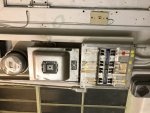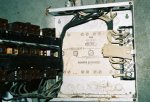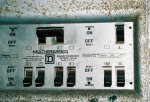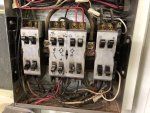You are using an out of date browser. It may not display this or other websites correctly.
You should upgrade or use an alternative browser.
You should upgrade or use an alternative browser.
Old Square D service panel
- Thread starter sw_ross
- Start date
- Status
- Not open for further replies.
LarryFine
Master Electrician Electric Contractor Richmond VA
- Location
- Henrico County, VA
- Occupation
- Electrical Contractor
Wasn’t able to find a date but I haven’t seen a service panel like this before.
I certainly have.
A lot of exposure to older equipment has to do with geography. Richmond, for example, has many homes that were built before electricity was distributed.
I've worked in many houses wired with K&T years after construction, as well as those wired during, the latter often mixed with black rigid conduit and BX.
zbang
Senior Member
- Location
- Roughly 5346 miles from Earls Court
It can't be that old, the knife switch is enclosed  .
.
Knuckle Dragger
Master Electrician Electrical Contractor 01752
- Location
- Marlborough, Massachusetts USA
- Occupation
- Electrical Contractor
I used to see quite a few of them in the past, not so much anymore.
ptonsparky
Tom
- Occupation
- EC - retired
As others have said, common enough in the past.
kwired
Electron manager
- Location
- NE Nebraska
- Occupation
- EC
I have seen that breaker type several times, but never a panel that could take that many breakers. All I can ever recall had 6 to 8 poles max.
junkhound
Senior Member
- Location
- Renton, WA
- Occupation
- EE, power electronics specialty
Moms house still has the SqD box and attached meter, big knife switch and 50A fuses - yep, 60A services. Acquired electricity circa 1914 or just after WW1. Original branch circuits were ceramic blocks with lead wire fuses and open knife switches in an asbestos cloth lined wooden box between wall studs.
Now has a 1950s 200A bulldog panel downstream but retains the 60 A fuses and knife stitched and indoor meter socket (with newer poco added modern transmitted reading meter). In the old days, no one (central IL) locked doors and meterman would just knock, call out 'meterman', and walk in.
Page 13 from 1918 has add for the SqD type switch.
https://books.google.com/books?id=x3o3AQAAMAAJ&pg=RA3-PA57&lpg=RA3-PA57&dq=1914+sqD+fuse+panel&source=bl&ots=jcgZDAnf4n&sig=ACfU3U1L2bWLxtL6r2xstVJeGmMCRCyczA&hl=en&sa=X&ved=2ahUKEwj26-6tjMfmAhUjGDQIHTKsBugQ6AEwE3oECAwQAg#v=onepage&q=1914%20sqD%20fuse%20panel&f=false
Now has a 1950s 200A bulldog panel downstream but retains the 60 A fuses and knife stitched and indoor meter socket (with newer poco added modern transmitted reading meter). In the old days, no one (central IL) locked doors and meterman would just knock, call out 'meterman', and walk in.
Page 13 from 1918 has add for the SqD type switch.
https://books.google.com/books?id=x3o3AQAAMAAJ&pg=RA3-PA57&lpg=RA3-PA57&dq=1914+sqD+fuse+panel&source=bl&ots=jcgZDAnf4n&sig=ACfU3U1L2bWLxtL6r2xstVJeGmMCRCyczA&hl=en&sa=X&ved=2ahUKEwj26-6tjMfmAhUjGDQIHTKsBugQ6AEwE3oECAwQAg#v=onepage&q=1914%20sqD%20fuse%20panel&f=false
al hildenbrand
Senior Member
- Location
- Minnesota
- Occupation
- Electrical Contractor, Electrical Consultant, Electrical Engineer
- Location
- Wisconsin
- Occupation
- PE (Retired) - Power Systems
Wasn’t able to find a date but I haven’t seen a service panel like this before.
Looks like a Multi-Open panel from the 30-40's.
al hildenbrand
Senior Member
- Location
- Minnesota
- Occupation
- Electrical Contractor, Electrical Consultant, Electrical Engineer
The Square D MultiBreaker line was Square D's first entry into the residential circuit breaker market in 1935. The breakers are factory installed to a internal tray that, when the cover is off the panel, is hinged to swing out and to one side of the panel. This permits routing all the neutrals along the back of the enclosure to a neutral bar mounted, not to the swing out tray, but to the main enclosure, actually BEHIND the breaker swing-out tray. The crazy thing, to me, is that one had to disconnect the feeder / service conductors from their lugs to swing out the tray to get at the neutral bar terminal screws. One is limited by the factory configurations of breakers.
I have, somewhere, a marketing advertisement showing a lady in full evening dress, resetting a breaker in a panel in the habitable portion of her house, with the caption to the effect that a breaker is simple, convenient and requires no parts to restore power in an overload outage.
I wondered what the “hinges” were for when I took the cover off. Also wonder how the heck you were supposed to get access to the neutral bar as I didn’t look accessible!
- Status
- Not open for further replies.




